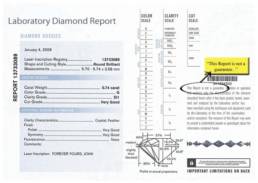Never Buy A Diamond On The Basis Of How It Is Described On a Piece of Paper

There are a multitude of companies that, for a fee, will examine a diamond and issue a written Report setting forth their opinion of the color, clarity and other characteristics. Such companies include the Gemological Institute of America (GIA), American Gem Society (AGS), European Gemological Laboratory (EGL), International Gemological Institute (IGI) and many others.
NEVER rely on such reports to make your buying decision.
The reasons are numerous:
a. None of the companies issuing the Reports guarantees their accuracy. All of the Reports contain a written disclaimer as to accuracy which states, in effect, that the company does not guarantee that anyone will agree with the Report and, further, that the company does not guarantee that even it will agree with the Report if the diamond is submitted to it for a subsequent examination.
b. Reports on the same diamond are notoriously inconsistent. If the same diamond is submitted to the companies for examination multiple times it is not uncommon for the multiple Reports to identify a spread of 3 clarity grades and 3 color grades for the same diamond.
c. It is not uncommon for vendors to submit the same diamond to the companies for examination multiple times and then pick and choose the “best” Report with which to market the diamond.
d. Clarity and color grades are ranges of clarity and color and not specific clarity or color. For example, a diamond graded SI2 in clarity on a Report could be almost the next higher clarity grade (SI1) or almost the next lower clarity grade (I1). Similarly, a diamond graded H in color on a Report could be almost the next higher color grade (G) or almost the next lower color grade (I). Therefore, one diamond described on a Report as SI2 clarity and H color could, in reality, be almost two clarity grades lower and two color grades lower than a second diamond described on a second Report as SI2 clarity and H color.
e. The most important characteristic of a diamond is its overall optical beauty. Optical beauty is the result of a complex inter-relationship of diamond proportions and light handling characteristics. No Report, including those that assign a “Cut” grade, provides sufficient information to determine whether and to what extent the inter-relationship of diamond proportions and light handling characteristics meet your personal definition of optical beauty.
f. Two diamonds with identical Reports can be, in reality, significantly different in terms of clarity, color, proportion, light handling characteristics, overall optical beauty and value. In fact, one diamond can be worth 300% more than the other.
g. The Reports are not truly independent opinions because the companies that provide such Reports are compensated to do so and are in competition with each other. Vendors want Reports showing the highest clarity and color grades for their diamonds. If two companies issue Reports, but one of the companies habitually gives the diamonds higher clarity and color grades, then that company might be favored by some vendors and, accordingly, might receive more examination fees. Put simply, in the Report business, it can pay to grade diamonds leniently.
h. Because of their inherent inaccuracies and inconsistencies, Reports do not provide a basis of comparison between or among diamonds as to actual clarity, color, proportions, light handling characteristics, overall optical beauty or value to provide a sufficiently reliable level of validity or accuracy for comparison purposes.
i. Reports are used by jewelry stores in an effort to persuade customers to “comparison shop” and make buying decisions based on what a piece of paper says about a diamond instead of based on what the diamond really is and really looks like. It is impossible to accurately comparison shop for diamonds based on Reports. Two diamonds that “sound” alike on their respective Reports can, in fact, be dramatically different in clarity, color, proportions, light handling characteristics, overall optical beauty and value. One can be worth 300% more than the other.
There is only one way to accurately observe the clarity, color, proportions, light handling characteristics and overall optical beauty of a diamond and evaluate its comparative value: Examine it with your own eyes.

